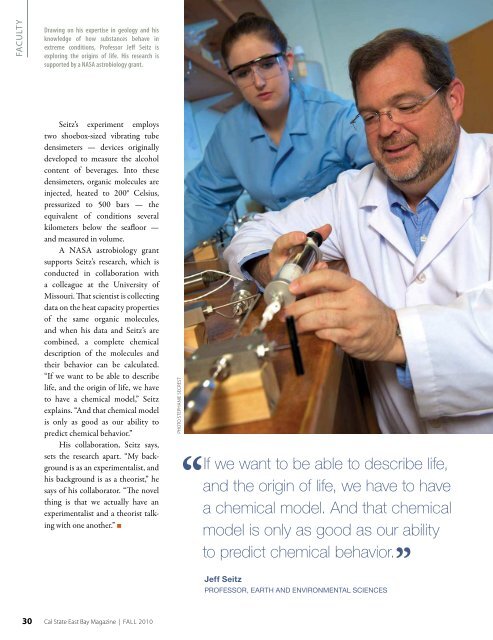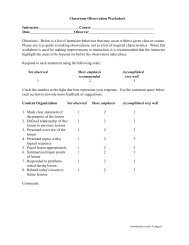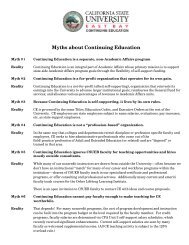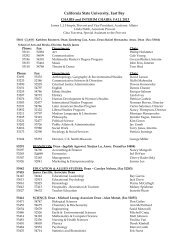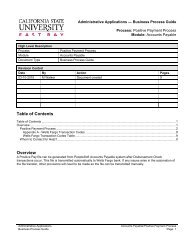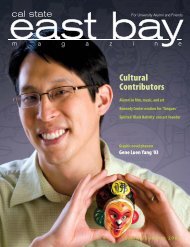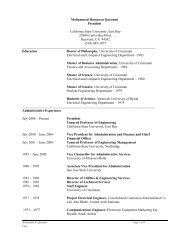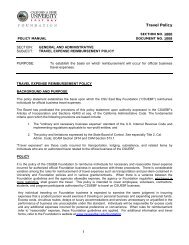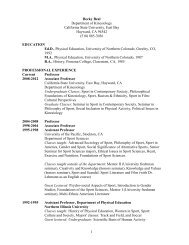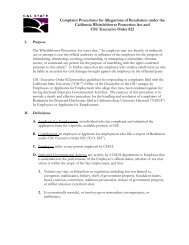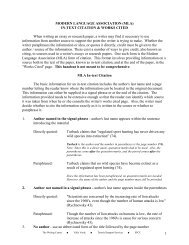Fall 2010 - California State University, East Bay
Fall 2010 - California State University, East Bay
Fall 2010 - California State University, East Bay
Create successful ePaper yourself
Turn your PDF publications into a flip-book with our unique Google optimized e-Paper software.
faculty<br />
Drawing on his expertise in geology and his<br />
knowledge of how substances behave in<br />
extreme conditions, Professor Jeff Seitz is<br />
exploring the origins of life. His research is<br />
supported by a NASA astrobiology grant.<br />
AssISTANT professor alleges Google share<br />
price manipulation<br />
Seitz’s experiment employs<br />
two shoebox-sized vibrating tube<br />
densimeters — devices originally<br />
developed to measure the alcohol<br />
content of beverages. Into these<br />
densimeters, organic molecules are<br />
injected, heated to 200° Celsius,<br />
pressurized to 500 bars — the<br />
equivalent of conditions several<br />
kilometers below the seafloor —<br />
and measured in volume.<br />
A NASA astrobiology grant<br />
supports Seitz’s research, which is<br />
conducted in collaboration with<br />
a colleague at the <strong>University</strong> of<br />
Missouri. That scientist is collecting<br />
data on the heat capacity properties<br />
of the same organic molecules,<br />
and when his data and Seitz’s are<br />
combined, a complete chemical<br />
description of the molecules and<br />
their behavior can be calculated.<br />
“If we want to be able to describe<br />
life, and the origin of life, we have<br />
to have a chemical model,” Seitz<br />
explains. “And that chemical model<br />
is only as good as our ability to<br />
predict chemical behavior.”<br />
His collaboration, Seitz says,<br />
sets the research apart. “My background<br />
is as an experimentalist, and<br />
his background is as a theorist,” he<br />
says of his collaborator. “The novel<br />
thing is that we actually have an<br />
experimentalist and a theorist talking<br />
with one another.” n<br />
PHOTO STEPHANIE SECREST<br />
“<br />
If we want to be able to describe life,<br />
and the origin of life, we have to have<br />
a chemical model. And that chemical<br />
model is only as good as our ability<br />
to predict chemical behavior.<br />
”<br />
Jeff Seitz<br />
BY Kim Girard<br />
It didn’t take long for Assistant Professor of Finance<br />
Jerry Liu to figure out that something fishy was going on with<br />
Google’s stock after the company’s initial public offering.<br />
Eight months after he posted a paper online about<br />
investor manipulation of Google stock during 2006 and<br />
2007, Liu received some validating news. The Securities and<br />
Exchange Commission and FBI arrested Raj Rajaratnam,<br />
founder of New York hedge fund management firm Galleon<br />
Group, in part for allegedly participating in Google-related<br />
insider trading.<br />
While Liu takes no credit for Rajaratnam’s October<br />
2009 arrest, he says the charges completely aligned with his<br />
research about Google stock manipulation. Liu’s research<br />
was published online in February 2009 and his findings later<br />
reported by Forbes.<br />
“My results were confirmed by the arrest,” Liu says.<br />
The SEC alleges Rajaratnam received information about<br />
Google weeks in advance of the company’s earnings release<br />
that allowed him to trade at an advantage. Rajaratnam, who<br />
has a net worth of $1.3 billion, was among six defendants<br />
charged with using insider information in schemes to<br />
trade in shares of companies including Google, Hilton<br />
Hotels Corp., and Advanced Micro Devices, according to<br />
Bloomberg News. The six allegedly earned more than $20<br />
million from the trades.<br />
Liu studied the market for options written to buy or sell<br />
Google, tracking it for the first 34 months that Google publicly<br />
traded. He specifically examined the stock’s movement near<br />
the search giant’s earnings release dates.<br />
What he found, and published in his report,<br />
was that “both news leaks and price control may<br />
have occurred during Google’s eight earnings release<br />
events in 2006 and 2007.”<br />
“It is obvious that the smart traders know,<br />
at least one week in advance, the direction of<br />
earning results before the official release,” he<br />
wrote in his report, “Has Google Stock Price Been<br />
Manipulated” “These leaks consistently occurred in all the<br />
eight earnings releases between 2006 and 2007.”<br />
The advance information helped some traders write<br />
so-called put and call options that paid off when the stocks<br />
moved near the strike price, Liu says. (The strike price is the<br />
price at which an investor who owns options to purchase<br />
a specific stock at a specific price may purchase that stock,<br />
potentially making a profit.) Liu also noted high incidences<br />
of “clustering,” which is when a stock’s closing price matches<br />
the strike price of one of its options on the day the option<br />
expires. This lets the writer of the option collect premiums<br />
and pay out virtually nothing, Forbes’s Asher Hawkins<br />
reported in a June 2009 article published in the magazine.<br />
Liu says Google “clustered” during the time of his study more<br />
than any other optionable stock.<br />
Liu, a former trader, says once he started tracking Google,<br />
it became “common sense” to him that its shares were being<br />
controlled. He says he sent a copy of his report to the SEC.<br />
Like many SEC critics, Liu believes the agency doesn’t<br />
hire enough math whizzes to stop insider trading and fraud<br />
as it’s happening. Part of the problem, he says, is that the SEC<br />
and Wall Street remain too tight-knit, which can contribute<br />
to fraud.<br />
Liu continues to track Google and says he suspects its<br />
shares are probably still being manipulated.<br />
Meantime, he says, he’ll also resume his research into<br />
how easy it is for big investors to manipulate the market and<br />
will keep sending his reports to the SEC. Given Liu’s unique<br />
perspective and inquiring mind, unscrupulous investors have a<br />
new reason to reconsider the temptations of ill-gotten profits. n<br />
30 Cal <strong>State</strong> <strong>East</strong> <strong>Bay</strong> Magazine | FALL <strong>2010</strong><br />
Professor, Earth and environmental sciences<br />
In studying changes in Google’s stock price, Assistant<br />
Professor Jerry Liu, right, noticed a pattern suggestive of<br />
insider trading. He published a report about his findings<br />
— later covered in Forbes.com — that proved prophetic.<br />
PHOTO STEPHANIE SECREST<br />
Cal <strong>State</strong> <strong>East</strong> <strong>Bay</strong> Magazine | FALL <strong>2010</strong><br />
31


